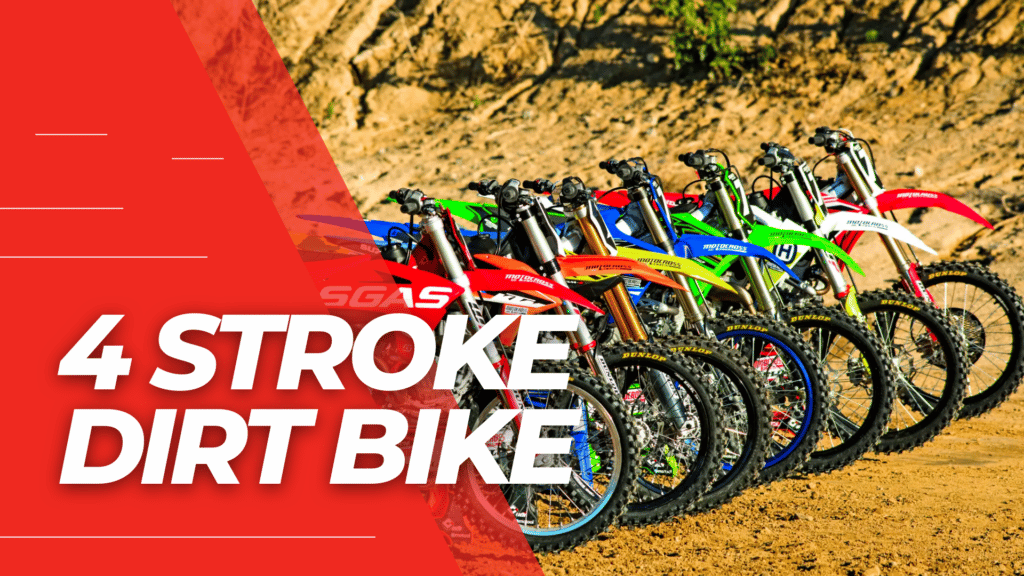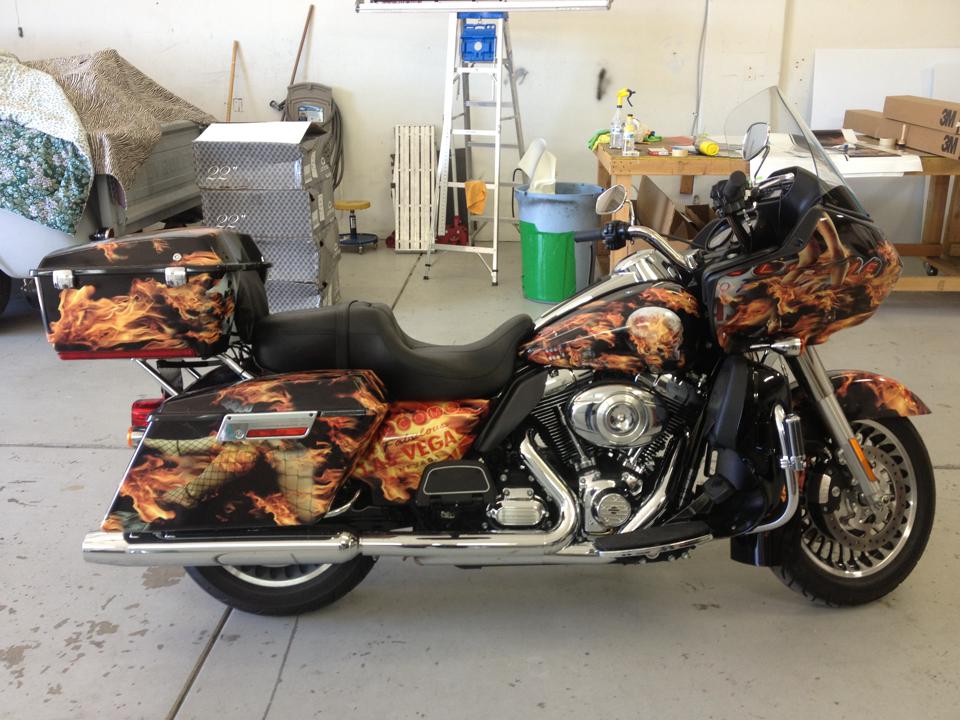If you watch the most popular dirt bike races on TV or attend them in person, you will see that nearly all the top riders are on a 4 stroke dirt bike. But, what exactly is it and how is it different from other types of dirt bikes?
In this article, I will explain what a 4 stroke dirt bike is, how they work, how long they last, when you need to do rebuilds and oil changes, and what you should consider when trying to decide if you should buy a 4 stroke or not.
What is a 4 Stroke Dirt Bike?
Before I get into the specifics of a 4 stroke dirt bike, let’s go over some dirt bike engine anatomy and terminology. This will make it easier to understand what a 4 stroke dirt bike is.
Dirt Bike Engine Anatomy
A few of the important parts of a dirt bike engine you need to understand in order to really get the difference between a 2 stroke and a 4 stroke are the cylinder head, piston, and crankshaft.
Cylinder Head
A cylinder head is a part of the engine that sits on top of the cylinder and houses the valves. The valves control the flow of air and fuel into and out of the engine. The cylinder head also includes the spark plug, which provides the spark that ignites the fuel and air mixture in the combustion chamber.
Below is a picture of a YZ250F cylinder head:
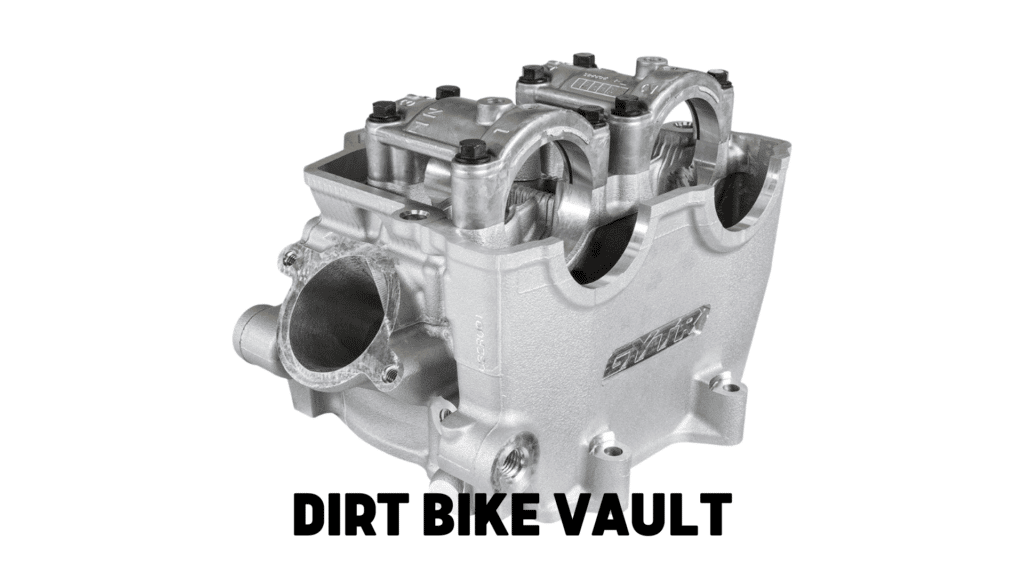
Piston
The piston fits inside the cylinder and moves up and down as the engine runs. From the top looking down, the piston is circular. Then below the piston is the connecting rod. As the name suggests, the connecting rod connects the piston to the crankshaft.
Below is a picture of a piston and the connecting rod.
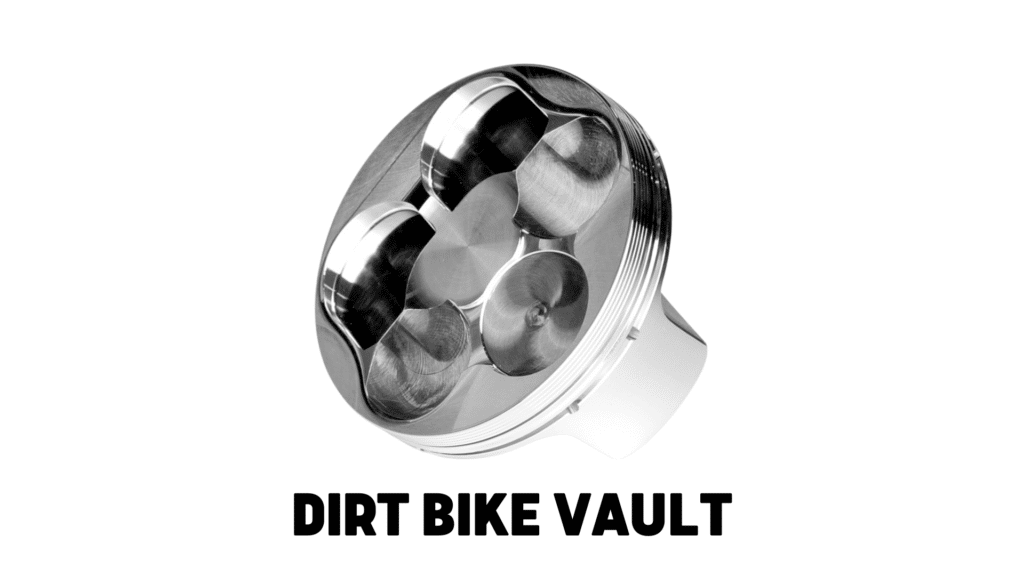
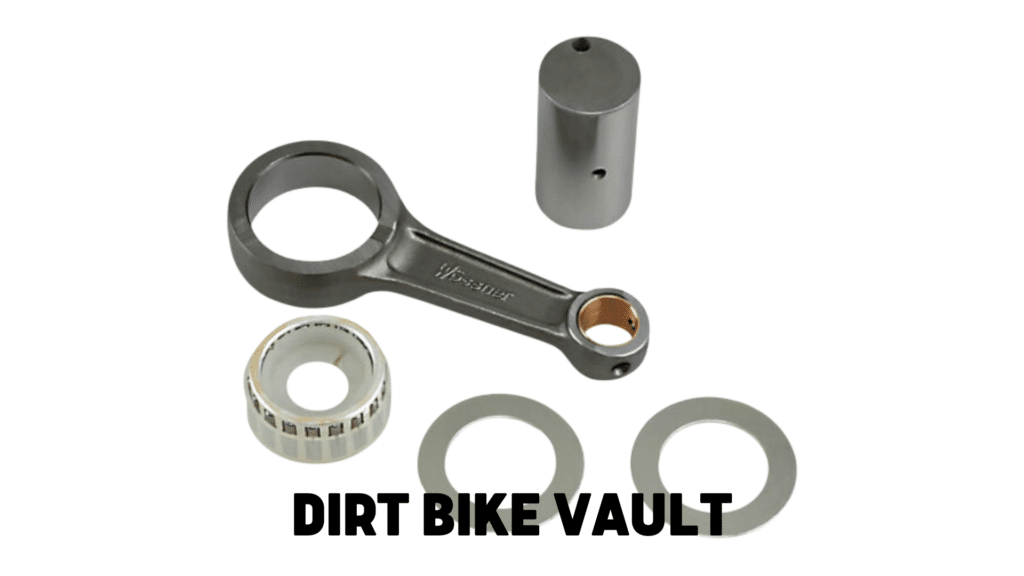
Crankshaft
In a dirt bike engine, the crankshaft runs through the center of the engine and converts the up-and-down motion of the piston, which I just explained, into a rotary motion. This rotary motion is used to power the wheels of the dirt bike.
Below is what a crankshaft looks like. You can see this crankshaft already has the connecting rod attached. The small circle at the bottom right is what connects to the piston.
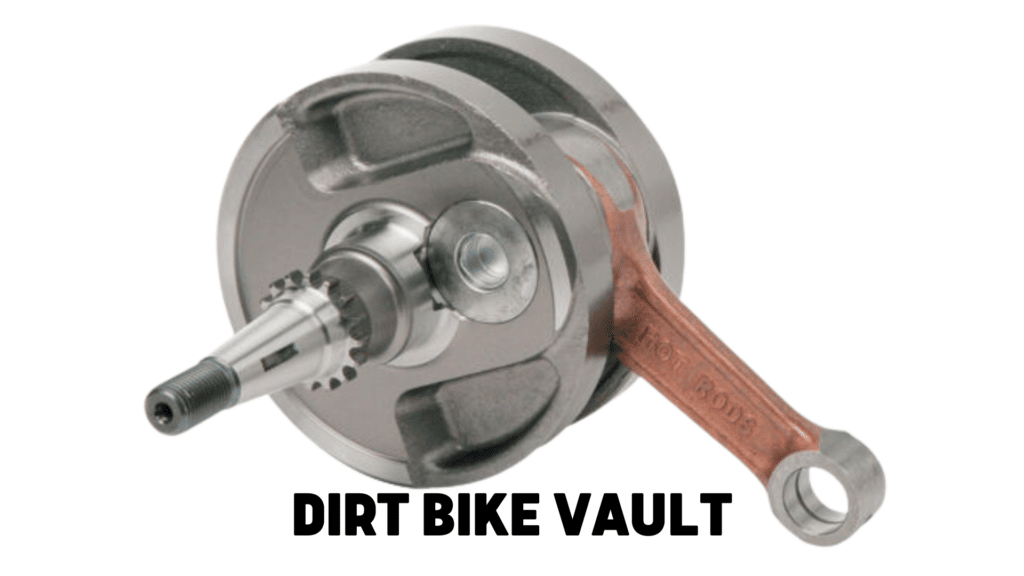
Okay, now that you understand these critical components of a dirt bike engine, let’s go over what a 4 stroke dirt bike is.
A 4 stroke dirt bike runs on purely gasoline, without any oil mixed in. You may have heard of “pre-mix” before, which means oil is premixed with the fuel before it goes in the bike. You may have also heard that 2 strokes have to have oil mixed with their fuel (pre-mix). 4 stroke dirt bikes don’t need that.
The piston of a 4 stroke engine goes up and down two times for every full combustion cycle, compared to only one time for a 2 stroke.
A 4 stroke dirt bike has four different, separate strokes: intake, compression, combustion, and exhaust. Whereas a 2 stroke dirt bike only has two separate strokes: scavending/compression and combustion/exhaust.
4 stroke engines require valves for both the intake and exhaust, whereas a 2 stroke doesn’t use either of them.
Below is a great visual representation of what I just explained.
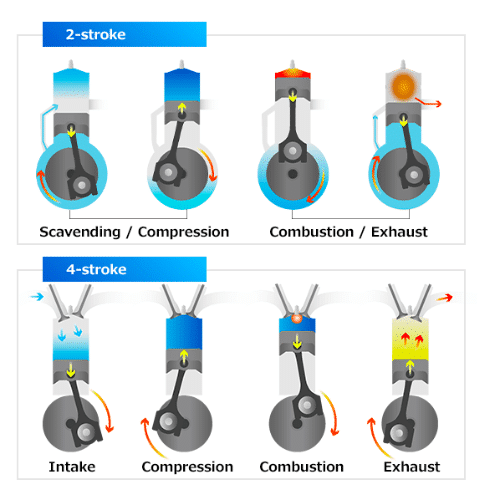
4 Stroke Dirt Bike Examples
These days, nearly every major manufacturer of dirt bikes makes a 4 stroke model. Below are the most popular models from the most popular manufacturers.
Yamaha 4 Stroke Dirt Bike
Yamaha has a full lineup of four-stroke dirt bikes across four different types: dual sport (think street-legal dirt bikes), trail, cross country, and motocross.
Yamaha’s dual sport lineup these days is comprised of the XT250 and the TW200.
Its trail lineup encompasses kids’ bikes, pit bikes, and adult bikes. For four strokes, this includes the TTR50, TTR110, TTR125, and TTR230.
As for Yamaha’s 4-stroke cross-country models, they offer the YZ250FX, WR250F, YZ450FX, and WR450F.
Finally, Yamaha’s motocross lineup. It’s quite similar to the cross-country lineup, except the model names and numbers don’t include an X. Yamaha 4 stroke motocross lineup is the YZ250F and YZ450F — both of which come in the regular edition or Monster Energy Yamaha Racing Edition.
Here is my brand new 2022 Yamaha YZ250F the day I bought it:

Honda 4 Stroke Dirt Bike
Honda categorizes its dirt bikes similar to Yamaha, but slightly differently. It has dual sport, trail, motocross, trials, and minimoto and adventure (both of which may or may not be considered a dirt bike depending on who you ask).
Honda’s entire dual sport lineup is 4 strokes these days, which includes the XR650L, CRF450RL, CRF300L Rally, and CRF300L. I personally ride an older CRF230M model.
All of Honda’s trail bikes are 4 stroke, like it’s dual sport bikes. Honda’s trail line includes the CRF450X, CRF450RX, CRF250F, CRF250RX, CRF125F (normal and big wheel), CRF110F, and CRF50F.
Back in the day, Honda had popular 2 stroke motocross dirt bikes, like the CR85 and CR125, but today, its entire motocross lineup is all 4 stroke dirt bikes. These models are the CRF450R, CRF450RWE, CRF450R-S, CRF250R, and CRF150R.
The last Honda 4 stroke dirt bike I’ll mention here is its trial bikes. No, not trail bikes, which we already covered. Trial bikes. “I” before “a.”
You know, those guys that hop around on the rear wheel and jump on and off stuff. Honestly, it’s crazy. Their bike control is unmatched.
Even Honda’s trial bikes are 4 strokes, and they have two models: Montesa Cota 4RT 301RR Race Replica and Montesa Cota 4RT 260R.
Kawasaki 4 Stroke Dirt Bike
Kawasaki classifies its dirt bikes into two groups: off-road/dual-sport/supermoto and motocross/cross-country. Under off-road/dual-sport/supermoto there are the KLR and KLX models and under the motocross/cross-country category, there are the KX models.
For the KLR models, there is only one, and it’s specifically a dual-sport: KLR650. For the off-road KLX models, there is the popular pit bike, KLX110R, as well as the KLX140R, KLX230R, and KLX300R. There are also two dual-sport KLX models, the KLX230 and the KLX300, and two supermoto KLX models, the KLX230SM and KLX300SM.
For the older readers, who remembers the awesome 2 stroke dual sport from Kawasaki? The KDX220.
Unlike Honda, but similar to Yamaha, Kawasaki does still make 2 stroke dirt bikes. Specifically, under its KX models, it makes three youth motocross bikes that are 2 strokes.
The rest of Kawasaki’s KX models are for adults and are 4 stroke dirt bikes. They offer the KX250, KX450, and KX450SR for motocross bikes and the KX250X and KX450X for cross-country bikes.
KTM 4 Stroke Dirt Bike
KTM is one of the major manufacturers that actually still makes quite a few 2 stroke models, but here I’ll be covering the KTM 4 stroke dirt bike models.
Under its MX category, KTM currently offers the 450 SX-F (Factory Edition and regular), 350 SX-F, and 250 SX-F (Factory Edition and regular).
For Enduro, KTM offers the 500 EXC-F (Six Days and regular), 350 EXC-F, 450 XCF-W, 350 XC-F (Factory Edition and regular), 450 XC-F, 350 XC-F, and 250 XC-F.
KTM also offers some badass Supermoto bikes, including the 690 SMC R and 450 SMR.
How to Break In a 4 Stroke Dirt Bike
Depending on who you ask on the internet, you’ll get different information on how to break-in the engine on a dirt bike. Some people will tell you that you don’t need to break it in at all — you can just start it up and ride it. Others will tell you that new dirt bike engines do need to be broken in.
I fall on the side of needing to break in the engine. Why?
Because there’s no downside and only upside. With not breaking it in, there’s no real upside, and only downside.
If you choose to not break in your dirt bike engine, sure, you get to ride a little bit sooner, but you could have major, expensive engine issues later because of it.
If you do break in your engine, it’s not guaranteed that you won’t have issues, but it lowers the probability, with no downside.
Assuming you agree now that you should break in your dirt bike engines, how do you do it?
Here’s how to break in a 4 stroke dirt bike:
Total Time: 1 hour and 30 minutes
Make sure the bike has fresh and clean fuel, as well as the correct fuel.
You do not want to use old or incorrect fuel. If it has been sitting in a gas can for months, or even weeks, you shouldn’t use it. You only don’t want to use pre-mix or other incorrect types of fuel.
Make sure the engine has the correct oil levels.
One of the most harmful things to a dirt bike engine is not running enough oil in it, and/or running the incorrect oil.
Complete 2-3 hot/cold cycles without riding the 4 stroke dirt bike.
Simply start the 4 stroke dirt bike and let it idle for 5-10 minutes until the engine gets hot. In the first cycle, you don’t want to go much over an idle. Turn the bike off and let the engine get completely cold. Not warm or mostly cold, completely cold. Then, complete another 1-2 hot/cold cycles. For these ones, you can slightly get on the throttle and increase the RPMs.
Complete 1-2 five to ten-minute rides while keeping the RPMs relatively low and ride in a gear higher than you would usually be in.
In these first 1-2 rides, you don’t want to be ringing the bike out and bouncing it off the rev limiter. Keep the RPMs low and ride the bike in a gear higher than you usually would. If you’d usually go through a corner in 2nd gear, be in 3rd while breaking it in.
Do an oil change and ride!
After the break-in procedure, do an oil change on your bike and then start enjoying it (with the peace of mind that you gave yourself the best chance of having your engine last a long time)!
How many hours do 4 stroke dirt bikes last?
It depends.
Isn’t that a great answer?
No, I know it’s not, but it’s the truth. There are a lot of factors that go into how many hours a 4 stroke dirt bike lasts.
For example, did you follow the steps above when breaking in your 4 stroke dirt bike or did you just hop on it and hammer it?
Other factors that determine how long many hours a bike lasts are the quality of the bike, the maintenance it receives, and how the bike is ridden.
If you buy a Chinese dirt bike vs a Japanese dirt bike, it’s likely not going to last as many hours.
If you never do any maintenance to your bike, it won’t last very long. Whereas, if you’re doing oil changes on a reasonable schedule, doing top ends and engine rebuilds as needed, etc., your dirt bike can last a lot longer.
Also, if you’re ringing the bike out all the time and racing it, it’s not going to last as many hours as a bike that is ridden more gently.
With poor maintenance and a bike being ridden hard, a 4 stroke dirt bike won’t last much past 40-50 hours. A well-maintained 4 stroke dirt bike can last upwards of 100+ hours.
How often should you rebuild a 4 stroke dirt bike?
The answer to how often should you rebuild a 4 stroke dirt bike is the same as how many hours do 4 stroke dirt bikes last. It depends.
If you’re not maintaining the bike or hammering down on it all the time, you’re going to need to rebuild a 4 stroke dirt bike sooner than if you just putt it around in the backyard.
It also depends what you’re using the bike for. If you’re a serious racer trying to make it to Loretta Lynn’s or go pro, you need to keep your engine fresh by rebuilding it often. Someone who is just having fun with their buddies as a hobby doesn’t have to rebuild a 4 stroke dirt bike as often.
That said, the owner’s manuals for my 2021 and 2022 YZ250Fs both say that the bikes need a piston at 12 hours. I personally rebuild top ends (piston, etc.) around 20-25 hours and bottom ends and/or full rebuilds around 50-75 hours.
You should consult your owner’s manual for the manufacturer’s recommended rebuild timeline.
How Often to Change 4 Stroke Dirt Bike Oil
Just like how long 4 stroke dirt bikes last or how often you should rebuild them, oil change frequency depends on how the bike is ridden and maintained.
If the bike is ridden in more harsh conditions, like mud, sand, being raced, or even if the rider is hard on the clutch, you should change the oil more frequently than if the bike is ridden softly in sunny, dry conditions.
Consistent and frequent oil changes are one of the best things you can do for your bike’s longevity. It’s relatively cheap and easy to do to really help your bike’s engine last longer. I change my 4 stroke dirt bike oil every 4-8 hours.
You should consult your owner’s manual for the manufacturer’s recommended oil change timeline.
2 Stroke vs 4 Stroke
Which is faster 2 Stroke or 4 Stroke Dirt Bike?
In general, with all else held equal, a 2 stroke is faster than a 4 stroke dirt bike. If you compare 2 strokes and 4 strokes with the same size engine, the 2 stroke should be faster.
For example, a 250 2 stroke dirt bike, such as a YZ250, is faster than a 250 4 stroke dirt bike, such as a YZ250F.
If you remember from earlier in the article, I mentioned that combustion takes place with each revolution of the crankshaft with a 2-stroke. This design puts out more power than a 4-stroke engine and the power has more instantaneous delivery, all of which plays into a 2-stroke being faster than a 4 stroke dirt bike.
Is a 4 Stroke Dirt Bike Good for Trail Riding?
Yes, a 4 stroke dirt bike is good for trail riding. 2 strokes are still fairly common in the world of trail riding and off-road racing, but 4 strokes are making a strong push into that world, as they have with motocross.
They have a smooth power delivery and a broader powerband, which allows for easy control and handling in different trail conditions. They also have more bottom end (low-end torque) that can be helpful in rocky terrain or hill climbs.
A personal favorite characteristic of mine is that 4 strokes are more fuel efficient than 2 strokes. When I ride my 2 stroke, I’m always re-fueling. When I ride my 4 stroke, the bike seems like it goes forever without needing more fuel. This makes for fun riding and less time filling up.
Should You Buy a 4 Stroke Dirt Bike?
Whether you should buy a 4 stroke dirt bike or not depends on what kind of riding you’re doing and what your goals are.
Generally, a 4 stroke will last a bit longer as it’s more durable, but it’s a lot more expensive to fix and rebuild the engine when you need to. On the other side, a 2 stroke won’t last as long between rebuilds, but it’s a lot cheaper to fix and rebuild.
When I was considering whether I wanted to buy a 4 stroke or a 2 stroke, I considered how often I’d be riding the bike. If I planned on riding a lot and putting a lot of hours on the bike, I tend to lean towards 2 strokes. If I don’t plan on riding the bike all that much and the hours will be kept relatively low, I lean towards 4 strokes.
I bought a 2 stroke to use as my “practice bike” since I would be putting 75-100+ hours on the bike in one season, and also bought a 4 stroke dirt bike to use as my race bike. I will still ride the 4 stroke for practice from time to time, but I will try to keep the hours low on this bike so the engine is fresh for racing and so that I don’t have to spend a ton of money rebuilding it.
A 2 stroke top end can be around $500 versus upwards of $1,500-$4,000+ for 4 stroke rebuilds.
Reader-Submitted Frequently Asked Questions About A 4 Stroke Dirt Bike
No, a 4-stroke does not take mixed gas.
4-stroke on a dirt bike means that the engine has four different, separate strokes: intake, compression, combustion, and exhaust, whereas a 2 stroke dirt bike only has two separate strokes: scavending/compression and combustion/exhaust.
Whether a 2 or 4-stroke is better depends on what kind of riding you’re doing and what your goals are. Generally, if you’re putting a lot of hours on the bike, I prefer 2-strokes, but if you’re going to be racing competitively, I prefer 4-stroke.
Yes, 4-stroke is good for dirt bike.
Yes, a 4-stroke is a good beginner bike — there is no oil to mix with the gas and the power delivery is more smooth than a 2-stroke.
No, you don’t add oil to 4 stroke gas.
A 4 stroke engine does need oil in it, but it does not need oil in the gas (like a 2-stroke).
Dirt bikes don’t need premium gas, but it is preferred. A dirt bike will run on lower quality fuel, such as 87 octane, but it likely won’t run as well and it won’t be as good for the dirt bike as premium gas.
